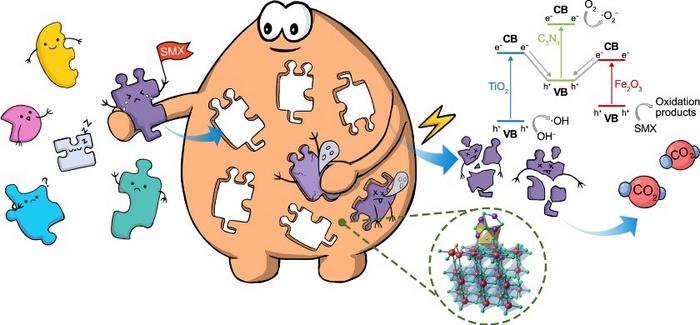In a new study published on 26 July 2023, in the journal Environmental Science and Ecotechnology, researchers from Harbin Institute of Technology, have developed a novel double Z-scheme photocatalyst, called the molecularly imprinted TiO2@Fe2O3@g-C3N4 (MFTC) composite, that selectively removes SMX from water.

Credit: Environmental Science and Ecotechnology
In a new study published on 26 July 2023, in the journal Environmental Science and Ecotechnology, researchers from Harbin Institute of Technology, have developed a novel double Z-scheme photocatalyst, called the molecularly imprinted TiO2@Fe2O3@g-C3N4 (MFTC) composite, that selectively removes SMX from water.
Traditional photocatalytic methods have faced challenges with selectivity, often causing the indiscriminate degradation of organic pollutants and coexisting contaminants at high concentrations. However, the MFTC composite was purposefully designed to overcome this limitation by incorporating molecularly imprinted sites on its surface. These specialized sites exhibit a unique ability to recognize and enhance the adsorption of sulfamethoxazole (SMX), making the MFTC highly effective in selectively targeting SMX in the presence of other pollutants like sulfadiazine (SDZ), ibuprofen (IBU), and bisphenol A (BPA). In simulated wastewater conditions, the MFTC composite impressively demonstrated a selective degradation efficiency rate of 96.8% for SMX, nearly twice as effective as competing catalysts for other pollutants. The “lock and key” mechanism of the molecularly imprinted sites played a pivotal role in selectively capturing SMX, resulting in superior performance. The degradation process of SMX by the MFTC photocatalytic system involved the generation of •OH and •O2− free radicals, which facilitated the removal of SMX through a newly proposed double Z-scheme mechanism. This mechanism enhanced charge carrier transfer and separation, leading to significantly improved photocatalytic activity. Moreover, the MFTC composite showcased remarkable stability and recyclability over multiple cycles, making it a promising and practical solution for water treatment applications. The exceptional performance and selectivity of the MFTC composite offer exciting prospects for the advancement of efficient and selective photocatalysts, contributing to the development of eco-friendly and cost-effective solutions for water purification and environmental remediation.
Highlights
- A novel double Z-scheme molecular imprinted (MI) photocatalyst was prepared.
- MI sites exhibited preferential recognition of sulfamethoxazole (SMX).
- Enhanced and selective oxidation of SMX was achieved in solar light.
- The band structure and degradation mechanism were calculated based on DFT.
- g-C3N4 served as electron ponds in the photocatalytic system.
This groundbreaking research not only provides valuable insights into the selective removal of sulfamethoxazole (SMX) but also opens the door for further exploration of molecularly imprinted nanocomposite materials in selectively eliminating other pharmaceutical residues and organic pollutants.
###
References
DOI
10.1016/j.ese.2023.100308
Funding information
The National Natural Science Foundation of China (52170073), The National Engineering Research Center for Bioenergy (2021A001), The Open Project of State Key Laboratory of Urban Water Resource and Environment (Harbin Institute of Technology) (HCK202112).
About Environmental Science and Ecotechnology
Environmental Science and Ecotechnology (ISSN 2666-4984) is an international, peer-reviewed, and open-access journal published by Elsevier. The journal publishes significant views and research across the full spectrum of ecology and environmental sciences, such as climate change, sustainability, biodiversity conservation, environment & health, green catalysis/processing for pollution control, and AI-driven environmental engineering. The latest impact factor of ESE is 12.6, according to the Journal Citation ReportTM 2022.
Journal
Environmental Science and Ecotechnology
DOI
10.1016/j.ese.2023.100308
Subject of Research
Not applicable
Article Title
Selective removal of sulfamethoxazole by a novel double Z-scheme photocatalyst: Preferential recognition and degradation mechanism
Article Publication Date
5-Sep-2023
COI Statement
The authors declare that they have no competing interests




